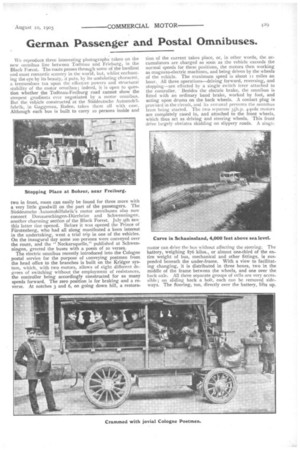German Passenger and Postal Omnibuses.
Page 15

If you've noticed an error in this article please click here to report it so we can fix it.
We reproduce three imeresting photographs taken on the new omnibus line between Totttnau and Frieburg, in the Black Forest. The route passes through some of the loveliest and most romantic scenery in the world, but, whilst enchanting the eye by its beauty, It puts, by its undulating character, a tremendous tax upon the effective powers and structural stability of the motor omnibus; indeed, it is open to question whether the Todtnau-Freiburg road cannot show the steepest gradients ever negotiated by a motor omnibus. But the vehicle constructed at the Siiddeutsche Automobilfabrik, in Gaggenau, Baden, takes them all with ease. Although each bus is built to carry lo persons inside and two in front, room can easily be found for three more with a very little goodwill on the part of the passengers. The Silddeutsche Au tomobilfabrik's motor omnibuses also now connect Donaueschingen-Diirrheim and Schwenningen, another charming section of the Black Forest. July gth saw this latter one opened. Before it was opened the Prince of Fiirstenberg, who had all along manifested a keen interest in the undertaking, went a trial trip in one of the vehicles. On the inaugural day some 200 persons were conveyed over the route, and the " Neckarsquelle," published at Schwenningen, greeted the buses with a poem of zo verses. The electric omnibus recently. introduced into the Cologne postal service for the purpose of conveying postmen from the head office to the branches is built on the Krieger system, which, with two motors, allows of eight different degrees of switching without the employment of resistances, the controller being accordingly constructed for as many speeds forward, The zero position is for braking and a reverse. At notches 3 and 6, on going down hill, a restora Lion of the current takes place, or, in other words, the accumulators are charged as soon as the vehicle exceeds the normal speeds for these positions, the motors then working as magneto-electric machines, and being driven by the wheels of the vehicle. The maximum speed is about it miles an hour. All three operations—driving forward, reversing, and stopping—are effected by a single switch lever attached to the controller. • Besides the electric brake, the omnibus is fitted with an ordinary band brake, worked by foot, and acting upon drums on the back wheels. A contact plug is proviued in the circuit, and its removal prevents the omnibus from being started. The two separate Ah.p. 4-pole motors are completely cased in, and attached to the front wheels, which thus act as driving and steering wheels. This front drive largely obviates skidding on slippery roads, A single motor can drive the bus without affecting the steering. The battery, weighing 876 kilos., or almost one-third of the entire weight of bus, mechanical and other fittings, is suspended beneath the under-frame. With a view to facilitating changing, it is distributed in three boxes, two in the middle of the frame between the wheels, and one over the back axle. All three separate groups of cells are very accessible; on sliding back a bolt, each can be removed sideways. The flooring, too, directly over the battery, lifts up.




















